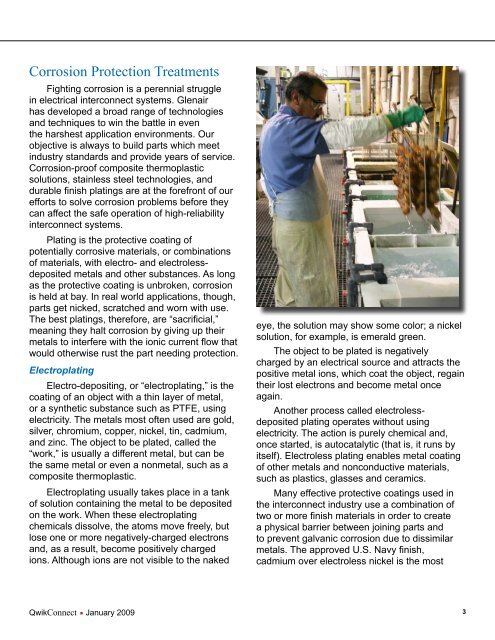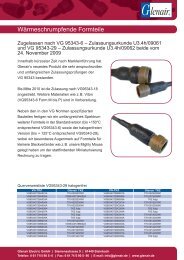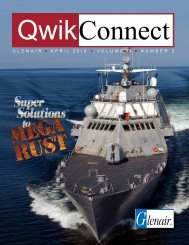RoHS - Glenair UK Ltd
RoHS - Glenair UK Ltd
RoHS - Glenair UK Ltd
Create successful ePaper yourself
Turn your PDF publications into a flip-book with our unique Google optimized e-Paper software.
Corrosion Protection Treatments<br />
Fighting corrosion is a perennial struggle<br />
in electrical interconnect systems. <strong>Glenair</strong><br />
has developed a broad range of technologies<br />
and techniques to win the battle in even<br />
the harshest application environments. Our<br />
objective is always to build parts which meet<br />
industry standards and provide years of service.<br />
Corrosion-proof composite thermoplastic<br />
solutions, stainless steel technologies, and<br />
durable finish platings are at the forefront of our<br />
efforts to solve corrosion problems before they<br />
can affect the safe operation of high-reliability<br />
interconnect systems.<br />
Plating is the protective coating of<br />
potentially corrosive materials, or combinations<br />
of materials, with electro- and electrolessdeposited<br />
metals and other substances. As long<br />
as the protective coating is unbroken, corrosion<br />
is held at bay. In real world applications, though,<br />
parts get nicked, scratched and worn with use.<br />
The best platings, therefore, are “sacrificial,”<br />
meaning they halt corrosion by giving up their<br />
metals to interfere with the ionic current flow that<br />
would otherwise rust the part needing protection.<br />
Electroplating<br />
Electro-depositing, or “electroplating,” is the<br />
coating of an object with a thin layer of metal,<br />
or a synthetic substance such as PTFE, using<br />
electricity. The metals most often used are gold,<br />
silver, chromium, copper, nickel, tin, cadmium,<br />
and zinc. The object to be plated, called the<br />
“work,” is usually a different metal, but can be<br />
the same metal or even a nonmetal, such as a<br />
composite thermoplastic.<br />
Electroplating usually takes place in a tank<br />
of solution containing the metal to be deposited<br />
on the work. When these electroplating<br />
chemicals dissolve, the atoms move freely, but<br />
lose one or more negatively-charged electrons<br />
and, as a result, become positively charged<br />
ions. Although ions are not visible to the naked<br />
QwikConnect n·<br />
January 2009<br />
eye, the solution may show some color; a nickel<br />
solution, for example, is emerald green.<br />
The object to be plated is negatively<br />
charged by an electrical source and attracts the<br />
positive metal ions, which coat the object, regain<br />
their lost electrons and become metal once<br />
again.<br />
Another process called electrolessdeposited<br />
plating operates without using<br />
electricity. The action is purely chemical and,<br />
once started, is autocatalytic (that is, it runs by<br />
itself). Electroless plating enables metal coating<br />
of other metals and nonconductive materials,<br />
such as plastics, glasses and ceramics.<br />
Many effective protective coatings used in<br />
the interconnect industry use a combination of<br />
two or more finish materials in order to create<br />
a physical barrier between joining parts and<br />
to prevent galvanic corrosion due to dissimilar<br />
metals. The approved U.S. Navy finish,<br />
cadmium over electroless nickel is the most<br />
3











